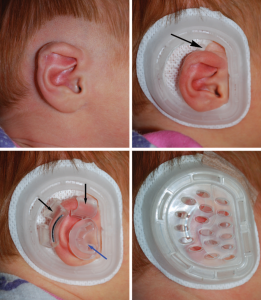Children are born with unique characteristics that make them special in their own way. However, some children may be born with ear deformities, which can affect their appearance and, in some cases, their hearing as well. There is a wide range of severity and type of ear deformities that happen in children. However, they cause concern for parents who want to know why these things happen and what can be done.
Here, we will explore the primary reasons for common ear deformities in children along with tips to help parents and caregivers better understand these conditions.
Common Reasons For Infant Ear Infection & Deformities
1. Genetic Factors
One of the most common reasons for ear deformities in children is genetics. Sometimes, children inherit the shape and size of their ears from their parents or grandparents. If there is a family history of ear deformities, there’s a higher chance that a child might also have similar ear characteristics. It’s important to remember that genetics play a significant role in ear deformities, but it’s not the only factor.
2. Intrauterine Positioning
During pregnancy, the position of the baby in the womb can affect the development of their ears. Pressure from the surrounding amniotic fluid and the mother’s body can sometimes lead to ear deformities. For example, if a baby’s head is consistently pressed against the mother’s pelvis or abdominal wall, it can cause changes in the shape of the ears. Newborn ear molding is one of the proven techniques to correct ear infections and deformities in children.
3. Premature Birth
Premature babies, who are born before the full term of pregnancy, are at a higher risk of developing ear deformities. Their ear cartilage might not have had enough time to fully harden and take its final shape before birth. This can result in baby ears that appear folded or misshapen.
4. Positional Deformation
Babies often spend a lot of time lying on their backs, especially when they sleep. If they consistently rest their head on one side, it can lead to positional deformation of the ears. It is often referred to as “flat head syndrome.” It doesn’t involve the actual ear cartilage but rather the soft tissues around the ear. However, it can make the baby’s ears appear misshapen.
5. Hemifacial Microsomia
Hemifacial microsomia is a rare condition in which one side of a child’s face, including the ear, is underdeveloped. This condition can cause noticeable differences in the appearance of the ear, including its size and shape. Hemifacial microsomia is thought to occur due to abnormal development of the first and second pharyngeal arches during fetal development.
6. Syndromes and Congenital Conditions
In some cases, ear deformities in children are associated with syndromes or congenital conditions. For example, children with Treacher-Collins syndrome often have underdeveloped cheekbones and lower jaw, which can affect the position and shape of the ears. Your child’s doctor needs to diagnose ear deformities and rule out any underlying syndromes or conditions. In such cases, parents may opt for ear molding for infants that helps in reshaping the ears without any surgical procedures.
7. Amniotic Band Syndrome
Amniotic band syndrome occurs when strands of the amniotic sac rupture and entangle parts of the developing fetus, including the ears. It can lead to various deformities, including constriction bands around the ear or even complete absence of parts of the ear. The severity of the deformity can vary widely depending on the extent of the complications.
Infant Ear Molding – A Non-Surgical Ear Correction Procedure at myPediaclinic
Parents want the best for their children, and that includes ensuring their child’s physical well-being and appearance. Infant ear deformities, such as protruding or misshapen ears, can be a source of concern for parents. However, there’s a non-surgical treatment available at myPediaclinic that can help address these issues – ear molding for infants. It is a proven procedure to help your child achieve optimal ear shape and symmetry.
Understanding Infant Ear Molding (Non-Surgical Ear Correction)

Infant Ear Molding, also known as ear splinting or ear reshaping, is a non-invasive and gentle procedure designed to correct ear deformities in infants. These deformities can be present at birth or develop shortly after. The procedure is typically performed during the first few weeks or months of a baby’s life when the ear cartilage is still soft and pliable.
How Infant Ear Molding (Non-Surgical Ear Correction) Works?
The process of ear molding for infants involves the use of specialized soft molds or splints that are custom-designed to gently reshape the baby’s ears. Here’s how the non-surgical ear correction procedure works at myPediaclinic:
1. Evaluation
The first step is a thorough evaluation by a Pediatric Specialist at myPediaclinic. They will assess the severity and nature of the ear deformity to determine if ear molding is a suitable solution for your child.
2. Custom-Made Splints
The custom-made splints in newborn ear molding are helpful to fit your baby’s ears precisely. These splints are soft, comfortable, and designed to provide the right amount of pressure to reshape the ear over time.
3. Regular Fittings
The splints are placed on your baby’s ears, and they are regularly adjusted by the medical team at myPediaclinic. These adjustments ensure that the child’s ears gradually take on a more symmetrical and pleasing shape.
4. Gentle and Pain-Free
The entire infant ear correction process is gentle and pain-free for your baby. The soft splints don’t cause discomfort, and they can be worn day and night without interfering with your baby’s routine.
5. Monitoring Progress
The medical team at myPediaclinic closely monitors the progress of the ear correction. They will ensure that the molds are effective and make any necessary adjustments during follow-up visits.
Advantages of Newborn Ear Molding at myPediaclinic
1. Early Intervention
Infant Ear Molding is most effective when started during the first few weeks or months of life. myPediaclinic specializes in early intervention, ensuring that your child gets the best results.
2. Non-Surgical Procedure
Unlike surgical procedures, infant ear molding is a non-surgical solution, eliminating the need for incisions or anesthesia. Thus, ear molding for infants is a safe and low-risk option for ear correction.
3. Customized Treatment & Care
Each baby’s ear deformity is unique, and myPediaclinic provides customized splints designed to address specific needs, ensuring optimal results.
4. Skilled Pediatric Specialists
myPediaclinic boasts a team of skilled and experienced Pediatric Specialists who are experts in infant ear molding, providing expert care and guidance throughout the process.
5. Enhanced Self-Esteem
Correcting ear deformities early can positively impact a child’s self-esteem, reducing the potential for teasing or self-consciousness as they grow older.
6. Avoid Costly Expenses in the Future
By embracing non-surgical newborn ear molding and seeking early intervention for your baby, parents can avoid the expenses of surgical ear molding procedures. Thus, non-surgical ear correction ensures a more cost-effective and less invasive solution for their child’s ear deformities.
Conclusion
Understanding the primary reasons for common ear deformities in children is crucial for parents and caregivers. With early diagnosis and through non-surgical methods (newborn ear molding), your child can lead happy and healthy lives with no ear deformities.
If you have concerns about your child’s ear development or appearance, consult with our Pediatric Specialists at myPediaclinic. Our experienced and professional Newborn Doctors can guide the best course of treatment and address any questions or concerns you may have.




